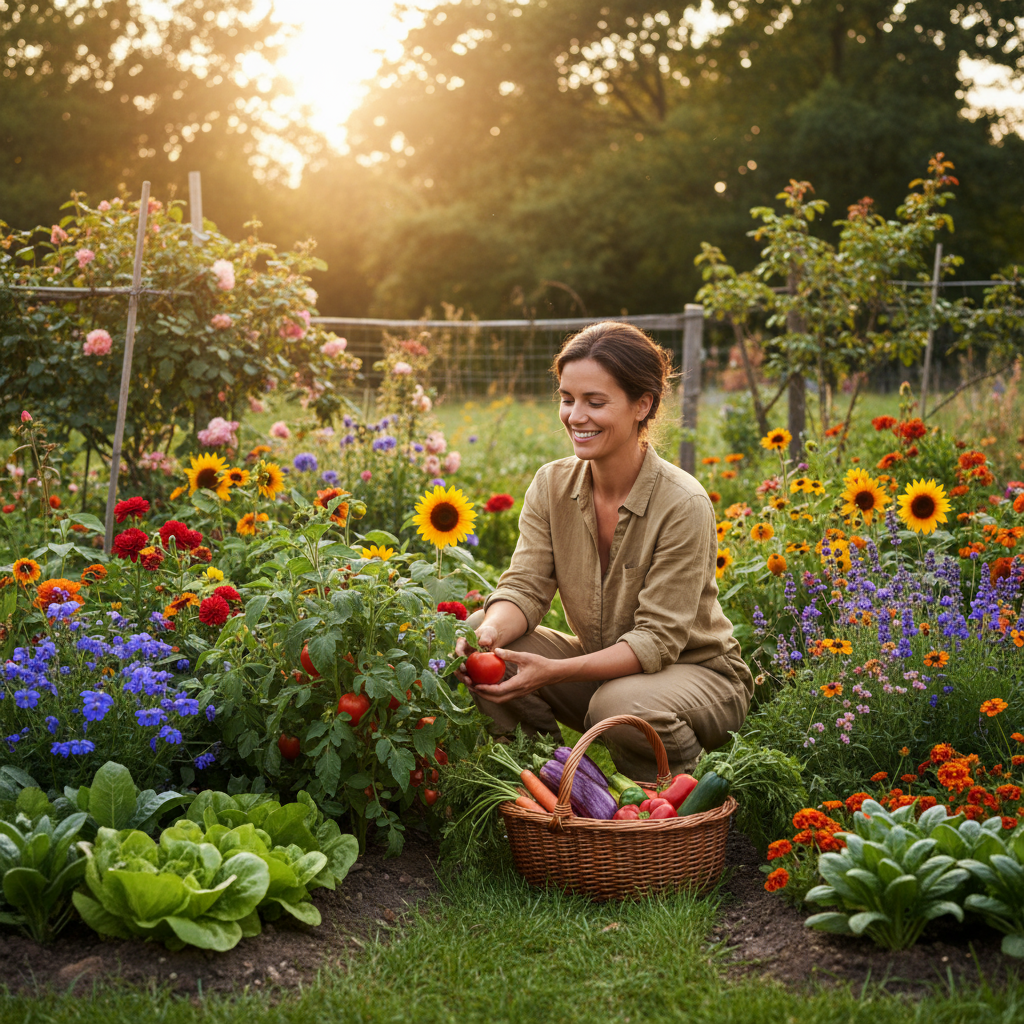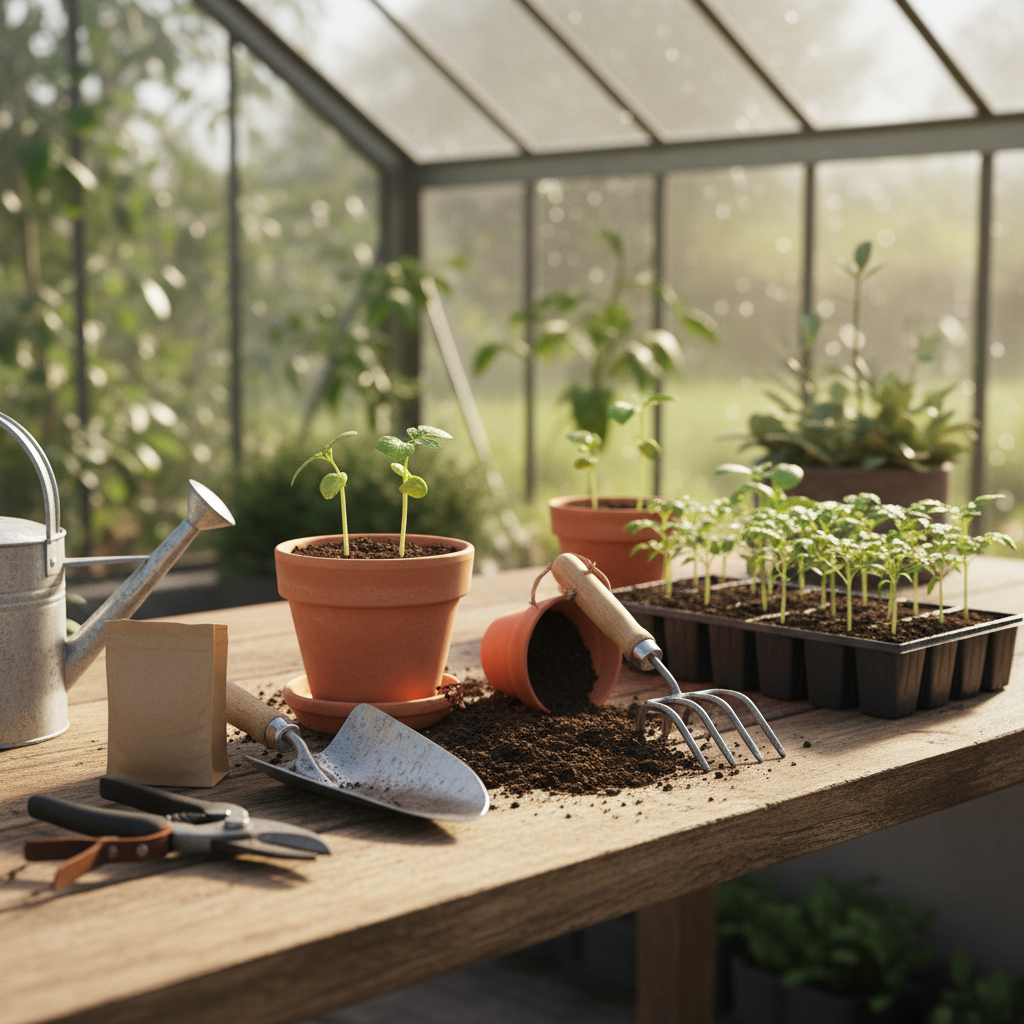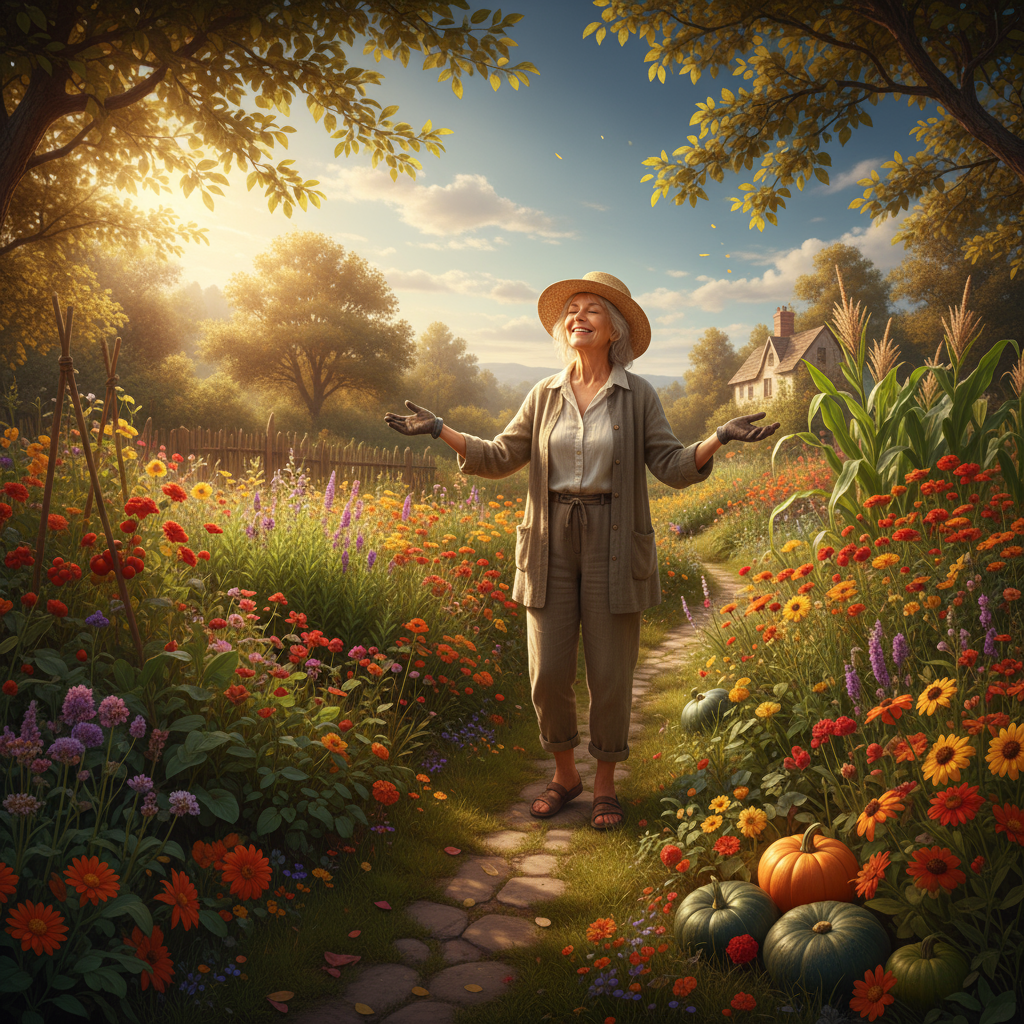
Table of Contents
Introduction
Picture this: you step outside and there’s your own little slice of paradise—fresh tomatoes hanging heavy on the vine, herbs that smell incredible, and flowers that make you smile every single day. Sounds pretty amazing, right? Look, I get it. Starting a garden can feel overwhelming when you’re just beginning. But here’s what I’ve learned: gardening isn’t just about plants. It’s about creating something beautiful with your own two hands, and trust me, there’s nothing quite like it.
The benefits? They go way beyond just having fresh veggies on your table (though that’s pretty great too). You’ll eat better, sure—organic produce you grew yourself tastes completely different. But gardening also does something special for your mental health. There’s actual science backing this up: digging in the dirt reduces stress, boosts your mood, and gives you this incredible sense of accomplishment. Want to get started on the right foot? These gardening tips for beginners will set you up for success. Whether you’ve got acres to work with or just a tiny balcony, we can make this work for your space.
Now, let’s talk about choosing your approach. Container gardening is perfect if you’re working with limited space—just grab some pots and you’re good to go. Raised beds give you better control over your soil and make maintenance so much easier (your back will thank you later). Got a big yard? Traditional in-ground gardening gives you all the freedom you want. If you’re leaning toward raised beds, definitely check out the raised bed gardening advantages to see if it’s your thing. And here’s something cool: working with native plants makes everything easier and helps your local ecosystem thrive. This guide to gardening with native plants will show you how to work with nature instead of against it.
You know what’s interesting? Gardening connects to so many other aspects of healthy living. Take eating more plant-based foods, for example. When you’re growing your own vegetables and herbs, you naturally start incorporating more of them into your meals. The plant based diet benefits are pretty incredible, and having a garden makes it so much easier to eat this way. Plus, there’s something deeply calming about working in the garden. It’s like meditation, but with dirt under your fingernails. If you’re dealing with stress (and who isn’t these days?), exploring different stress reduction methods alongside gardening can create this wonderful wellness routine that actually sticks.
What You’ll Learn in This Guide
We’re going to walk through everything you need to know to start your own garden—no experience required. By the time you’re done reading, you’ll feel confident enough to get your hands dirty and start growing.
- Choosing Your Garden Type: We’ll break down container gardening, raised beds, and traditional in-ground planting. You’ll figure out which approach works best for your space, climate, and how much time you want to spend maintaining things.
- Planning and Preparing: This is where the magic happens before you even plant anything. We’ll cover finding the perfect spot, understanding sunlight patterns, building healthy soil (composting is easier than you think), and getting the right tools without breaking the bank.
- Planting Basics: Should you start from seeds or buy seedlings? What plants are actually beginner-friendly? We’ll cover the fundamentals of getting plants in the ground the right way so they’ll thrive instead of just survive.
- Garden Maintenance: The ongoing care that keeps your garden happy—watering without overdoing it, dealing with weeds and pests naturally, and knowing when and how to harvest. This stuff becomes second nature faster than you’d think.
As we dive deeper, you’ll discover techniques that’ll help your garden flourish long-term. We’ll talk about when it makes sense to ask for help and how to troubleshoot common problems before they become disasters. Want to expand your garden without spending a fortune? Learn how to propagate plants and multiply what you’ve got. And if you really want to set yourself up for success, understanding how to prepare garden soil for thriving growth is a game-changer. With these skills, you’ll create something that brings you joy and puts fresh food on your table all season long.
Here’s the thing about gardening—it’s not really about the plants at all. It’s about slowing down, paying attention, and creating something meaningful with your hands. This guide will help you turn whatever space you have into your own little oasis. Dreaming of colorful flowers? A veggie garden that feeds your family? Maybe a bit of both? We’ve got you covered every step of the way.
Ready to get started? Let’s dig in together and discover just how rewarding this journey can be. Your future self (and your dinner table) will thank you for taking this first step.

Gardening? It’s one of those hobbies that gets under your skin in the best possible way. Sure, it’s great for your body (hello, natural workout!), your mind (goodbye, stress!), and the environment. But here’s the thing—when you’re just starting out, it can feel like information overload. Which plants should you choose? What’s the deal with different soil types? Where do you even begin? Don’t worry. We’ve all been there, staring at that patch of dirt wondering if we’re about to kill every plant we touch. The secret is having a solid game plan and understanding the basics before you dive in. Let’s walk through the essentials that’ll set you up for gardening success (and maybe even keep your plants alive in the process).
Choosing the Best Garden Type for Your Space and Needs
Here’s where things get interesting—not all gardens are created equal. Before you get excited about planting anything, you need to figure out what type of garden actually makes sense for your situation. Your available space, how much time you want to spend maintaining things, and what you’re hoping to grow all play into this decision. Think you’re stuck because you only have a tiny balcony? Think again. Container gardening might just be your new best friend. You can control the soil completely, move plants around when needed, and experiment without committing to a huge garden bed. It’s like gardening with training wheels—but in a good way. Want to dive deeper into getting started? This gardening tips for beginners guide has everything you need to know.
Now, if you’ve got a bit more space but your soil looks like it hasn’t seen love in decades, raised bed gardening could be your answer. Picture this: elevated planting areas that drain better, give you control over soil quality, and save your back from all that bending. Plus, they extend your growing season and keep weeds from taking over your life. (Trust me, anything that reduces weeding is worth considering.) The raised bed gardening advantages guide breaks down why so many gardeners swear by this method. But maybe you’re thinking bigger—you’ve got the yard space and you’re ready to go all-in with traditional in-ground gardening. That’s fantastic, but here’s the catch: your soil needs to be ready for the challenge. This means testing, amending, and preparing it properly. The how to prepare garden soil guide will walk you through creating that strong foundation your plants are going to love.
Key Aspects of Choosing Your Garden Type
Each approach has its own personality, and understanding what you’re getting into will save you headaches later:
- Space Availability and Flexibility: Container gardening works magic in tight spaces and lets you rearrange things on a whim, while raised beds and in-ground gardens need their own dedicated real estate but give you room to really spread out.
- Soil Quality and Management: Raised beds put you in the driver’s seat when it comes to soil composition and drainage—which plants absolutely love—while in-ground gardening means you’ll need to test your soil and probably give it some TLC with amendments.
- Maintenance and Accessibility: Raised beds are a godsend if bending over isn’t your favorite activity, and containers make dealing with pests and watering so much simpler.
- Plant Selection and Growing Season: Your garden type actually influences what you can grow and how well it’ll do. Containers and raised beds let you extend your growing season and try different crops by controlling the soil and microclimate.
The bottom line? Pick the garden type that fits your life, not the one that looks prettiest on Instagram. When you match your garden to your space, resources, and goals, everything just works better. Your plants will thrive, and you’ll actually enjoy the process instead of fighting it. With that foundation sorted, let’s talk about the planning and prep work that’ll set you up for long-term success.
Planning and Preparing Your Garden for Long-Term Success
Here’s where the magic really happens—in the planning stage. I know, I know, you probably want to start planting right now. But stick with me here, because getting this part right makes everything else so much easier. First things first: you need to become a detective about your garden location. How much sunlight does it actually get? (Spoiler alert: “some sun” isn’t specific enough.) What’s your soil situation? Is it protected from harsh weather, or does it get hammered by wind and storms? Most plants need at least six hours of direct sunlight daily, so this isn’t negotiable. If you’re curious about creating the right environment for plants from the start, check out this guide on how to propagate plants—it covers light and environmental needs that’ll help your garden babies thrive. Then there’s soil prep, which honestly deserves its own celebration when done right. Think of compost as plant food that keeps on giving—it improves soil structure, boosts nutrients, and helps your soil hold onto moisture without getting waterlogged.
And here’s something many beginners skip (don’t be one of them): soil testing. Yes, it sounds boring, but it’s like getting a health checkup for your garden. You’ll discover if your pH is off or if you’re missing key nutrients, which means you can fix problems before they become disasters. As for tools, you don’t need to break the bank, but having the right basics—a good trowel, sharp pruners, comfortable gloves, a decent watering can, and that soil testing kit—will make your life infinitely easier. For more specific guidance on starting strong, the how to start a flower garden guide has detailed prep and planting techniques that work for any type of garden. When you combine smart location choices, properly prepared soil, and the right tools, you’re not just planting a garden—you’re creating an environment where plants want to grow year after year.
Key Aspects of Planning and Preparing Your Garden
Focus on these fundamentals, and you’ll be amazed at the difference they make:
- Sunlight Assessment and Microclimate Considerations: Actually track how much sun your space gets throughout the day, note where shadows fall, and pay attention to wind patterns—these details determine whether your plants will flourish or just survive.
- Soil Testing and Enrichment: Test for pH and nutrient levels, then work in compost, organic fertilizers, or other amendments to create soil that plants can’t resist growing in.
- Essential Gardening Tools and Equipment: Start with quality basics like hand trowels, pruning shears, a reliable watering system, and protective gloves—good tools make gardening a pleasure instead of a chore.
- Water Access and Irrigation Planning: Make sure you can easily reach your plants with water, and consider drip irrigation or soaker hoses to keep moisture consistent while being smart about water use and reducing plant stress.

There’s something magical about starting your own garden—and honestly, it’s simpler than you might think. Whether you’re working with containers on a tiny balcony, building raised beds in your backyard, or going the traditional in-ground route, you’re already making the right choice for your space. The real game-changer? Getting the basics right from day one. Think sunlight, soil health, and having the right tools within arm’s reach. Once you nail these fundamentals, you’re setting your plants up for success (and yourself up for those satisfying “look what I grew!” moments).
Here’s where it gets real—gardens need love, and that means showing up consistently. Watering, dealing with the occasional pest party, and giving your plants the pruning they need. But here’s what surprised me: it’s not just about keeping things alive. Gardening becomes this amazing mental reset button. Bad day at work? Twenty minutes with your tomatoes will sort you right out. There’s something about getting your hands dirty that just… works.
Want to take this whole garden thing to the next level? Your homegrown veggies pair beautifully with a plant-based diet—talk about farm-to-table satisfaction. And since gardening is basically meditation in disguise, why not explore other stress reduction methods that complement those zen garden vibes? Plus, all that fresh produce you’re growing? Perfect for easy vegan meal prep recipes that’ll make your future self thank you. Speaking of mindful living, mindfulness meditation and gardening go together like peas and carrots—both teach you patience, presence, and the art of just being.
Look, gardening isn’t about perfection. Some seasons will be amazing, others might leave you wondering what went wrong with those supposedly “foolproof” herbs. That’s all part of it. The real joy lives in those quiet morning moments when you’re checking on your plants, or the pride you feel when you serve dinner made entirely from your own backyard. So grab your gloves, step outside, and start small. Your garden—and honestly, your sanity—will thank you for it.
Frequently Asked Questions
-
What is the easiest type of garden to start?
- Go with containers or raised beds if you’re just starting out. They’re way more forgiving, and you get to control everything—soil, drainage, even where they sit if you need to move them around.
-
How often should I water my garden?
- Most gardens do fine with a good drink once or twice a week, but it really depends on your plants and weather. Stick your finger into the soil—if it’s dry a couple inches down, it’s time to water.
-
Can I start a garden with minimal space?
- Absolutely! Container gardening is perfect for apartments, balconies, or anywhere space is tight. You’d be surprised how much you can grow in pots—herbs, tomatoes, even small fruit trees.
-
When should I call a gardening expert?
- When your plants are clearly unhappy and you’ve tried everything you can think of. Persistent diseases, bug problems that won’t quit, or soil that just isn’t working—sometimes you need a pro to figure out what’s going on.
